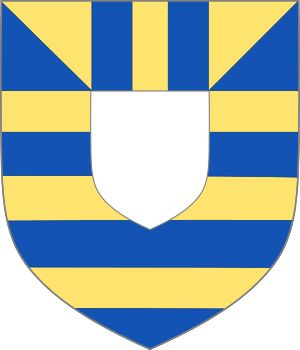Edmund Mortimer, 2nd Baron Mortimer of Wigmore facts for kids
Quick facts for kids
Edmund Mortimer
|
|
|---|---|
| Baron Mortimer of Wigmore | |

Arms of Mortimer: Barry or and azure, on a chief of the first two pallets between two base esquires of the second over all an inescutcheon argent
|
|
| Born | c. 1251 |
| Died | 17 July 1304 Wigmore Castle |
| Buried | Wigmore Abbey |
| Noble family | Mortimer |
| Spouse(s) | Margaret de Fiennes |
| Issue | Roger Mortimer, 1st Earl of March Matilda Mortimer John Mortimer Walter Mortimer Edmund Mortimer Hugh Mortimer |
| Father | Roger Mortimer, 1st Baron Mortimer |
| Mother | Maud de Braose |
Edmund Mortimer, 2nd Baron Mortimer of Wigmore (born around 1251 – died July 17, 1304) was an important English noble. He was the second son of Roger Mortimer, 1st Baron Mortimer of Wigmore. His mother was Maud de Braose. Edmund became the head of his family after his older brother passed away.
Contents
Edmund Mortimer's Life Story
Early Life and Education
As a younger son, Edmund was first expected to become a priest or a monk. He went to study at Oxford University, a famous school. In 1265, he became the financial manager for the church in York. By 1268, he was studying religion with the Archbishop of York. King Henry III of England even sent him deer meat, which was a special treat.
Becoming the Family Heir
However, Edmund's life path changed suddenly. His older brother, Ralph, died in 1274. This meant Edmund became the next in line to inherit the family's lands and titles. Even so, he kept studying at Oxford for a while. But when his father died, Edmund had to leave his studies. He returned home to take on his new responsibilities.
Edmund's Role in Wales
In 1282, Edmund became the new Baron Mortimer of Wigmore. He quickly got involved in the politics of the Welsh Marches. These were the border lands between England and Wales. He worked with his brother Roger Mortimer, 1st Baron Mortimer of Chirk and other nobles.
The Battle of Orewin Bridge
Edmund and his allies made a plan to capture Llywelyn ap Gruffudd. Llywelyn was the Prince of Wales and a relative of Edmund. Edmund sent a message to Llywelyn, pretending to offer help. They arranged to meet near Builth. At a place called Orewin Bridge, Llywelyn became separated from his army. Edmund's brothers secretly crossed the river behind Llywelyn's forces. They surprised the Welsh army. In the fight that followed, known as the Battle of Orewin Bridge, Prince Llywelyn was killed.
Service to the King and Death
For his help in Wales, King Edward I made Edmund a knight in 1283. This happened in Winchester. Edmund also served the king in battles in Scotland. Later, he returned to Wales to fight again. He was badly wounded in a small battle near Builth. Edmund died from his injuries at Wigmore Castle on July 17, 1304.
Edmund's Family
Marriage and Children
In September 1285, Edmund married Margaret de Fiennes. Her family was connected to royal bloodlines. Edmund and Margaret had several children who survived:
- Roger Mortimer, 1st Earl of March (born April 25, 1287 – died November 29, 1330). He married Joan de Geneville and they had twelve children.
- Maud de Mortimer. She married Sir Theobald II de Verdun in 1302. They had four daughters.
- John de Mortimer. He died accidentally during a jousting match.
- Walter de Mortimer. He became a priest and was the Rector of Kingston.
- Edmund de Mortimer. He also became a priest and was the Rector of Hodnet, Shropshire. He was also a financial manager for the cathedral at York.
- Hugh de Mortimer. He became a priest and was the Rector of the church at Old Radnor.
Edmund and Margaret also had two daughters, Elizabeth and Joan, who became nuns.

